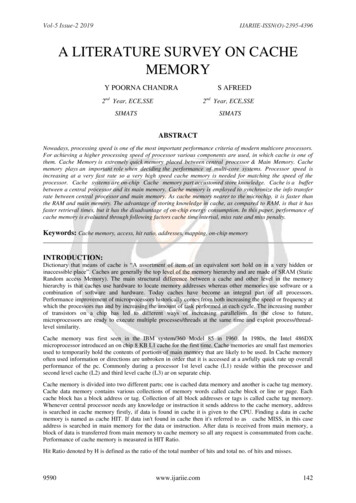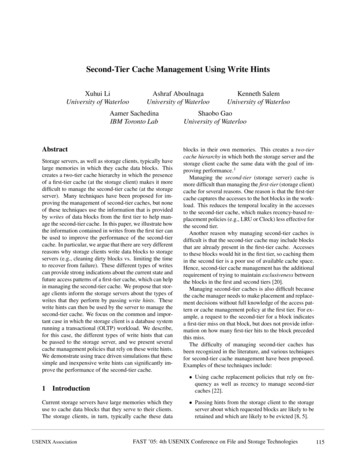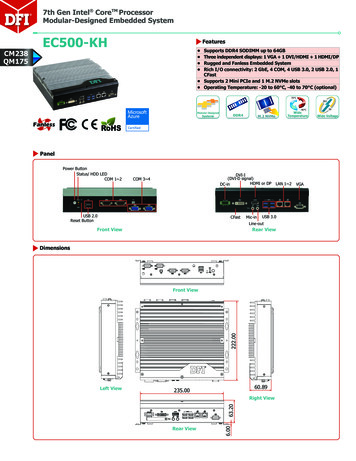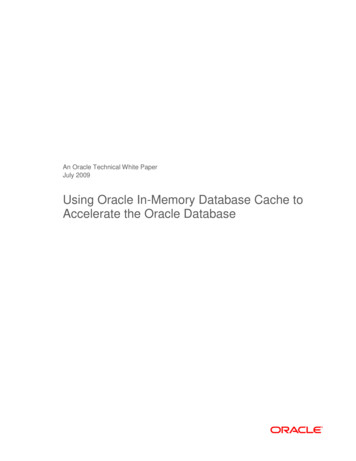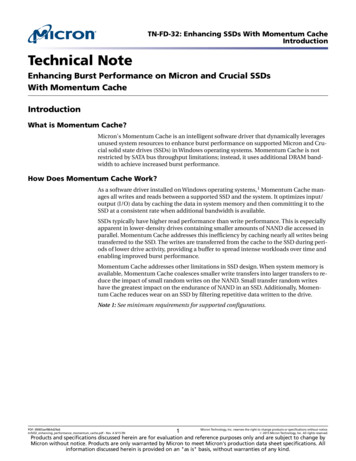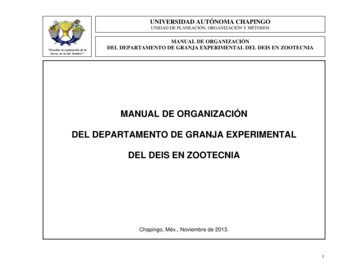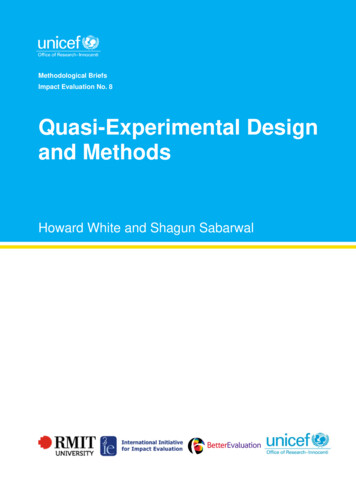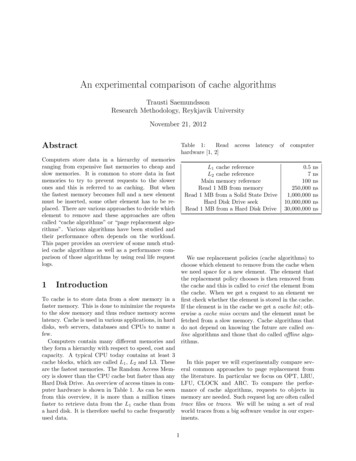
Transcription
An experimental comparison of cache algorithmsTrausti SaemundssonResearch Methodology, Reykjavik UniversityNovember 21, 2012AbstractTable 1:Readhardware [1, 2]accesslatencyofcomputerComputers store data in a hierarchy of memoriesranging from expensive fast memories to cheap andL1 cache reference0.5 nsslow memories. It is common to store data in fastL2 cache reference7 nsmemories to try to prevent requests to the slowerMain memory reference100 nsones and this is referred to as caching. But whenRead 1 MB from memory250,000 nsthe fastest memory becomes full and a new elementRead 1 MB from a Solid State Drive1,000,000 nsmust be inserted, some other element has to be reHard Disk Drive seek10,000,000 nsplaced. There are various approaches to decide whichRead 1 MB from a Hard Disk Drive 30,000,000 nselement to remove and these approaches are oftencalled “cache algorithms” or “page replacement algorithms”. Various algorithms have been studied andtheir performance often depends on the workload.This paper provides an overview of some much studied cache algorithms as well as a performance comparison of those algorithms by using real life requestWe use replacement policies (cache algorithms) tologs.choose which element to remove from the cache whenwe need space for a new element. The element thatthe replacement policy chooses is then removed from1 Introductionthe cache and this is called to evict the element fromthe cache. When we get a request to an element weTo cache is to store data from a slow memory in a first check whether the element is stored in the cache.faster memory. This is done to minimize the requests If the element is in the cache we get a cache hit; othto the slow memory and thus reduce memory access erwise a cache miss occurs and the element must belatency. Cache is used in various applications, in hard fetched from a slow memory. Cache algorithms thatdisks, web servers, databases and CPUs to name a do not depend on knowing the future are called onfew.line algorithms and those that do called offline algoComputers contain many different memories and rithms.they form a hierarchy with respect to speed, cost andcapacity. A typical CPU today contains at least 3cache blocks, which are called L1 , L2 and L3. TheseIn this paper we will experimentally compare sevare the fastest memories. The Random Access Mem- eral common approaches to page replacement fromory is slower than the CPU cache but faster than any the literature. In particular we focus on OPT, LRU,Hard Disk Drive. An overview of access times in com- LFU, CLOCK and ARC. To compare the perforputer hardware is shown in Table 1. As can be seen mance of cache algorithms, requests to objects infrom this overview, it is more than a million times memory are needed. Such request log are often calledfaster to retrieve data from the L1 cache than from trace files or traces. We will be using a set of reala hard disk. It is therefore useful to cache frequently world traces from a big software vendor in our experused data.iments.1
2Cacherithmsreplacementalgo-However, implementing LFU requires keeping trackof the request frequency of each element in the cache.Usually this is done with some number of bits for eachelement and the number of bits limits how accuratelythe frequency is monitored. Regardless of the numberof bits, keeping track of which element has the lowestfrequency requires a priority queue and hence LFUhas logarithmic complexity for all operations.We now give an overview af cache algorithms, starting with an optimal one and working towards morepractical ones.2.1Belady’s algorithmL. A. Belady described an optimal cache algorithm [3](OPT) in 1966. When the cache is full and a newelement must be inserted, OPT replaces the elementthat will not get a cache request for the longest periodof time in the future. In practice cache sequencesarrive in an online fashion and we cannot know thefuture requests. Therefore OPT cannot be used inpractice but it is an important baseline with whichto compare other algorithms.2.22.4CLOCKIntroduced in 1968 [5] by F. J. Corbato, the CLOCKalgorithm arranges cache elements in a circle and captures the recency of a workload like LRU with muchless effort.Every element has an associated bit called the recently used bit, which is set every time an element isaccessed. The clock data structure has one “hand”.When an element needs to be evicted from the cache,we check whether the recently used bit is set on theelement E to which the hand points. If the recentlyused bit is not set on E, we replace E with the newelement. However if the recently bit is set on E, weunset the bit on E and advance the hand to the nextelement. We repeat this until we find an element thatdoes not have the recently used bit set. In the worstcase the hand must traverse an entire circle and remove the element to which it pointed originally.CLOCK handles recency like LRU without requiring locks in parallel systems. CLOCK also handlesmore requests per time unit because it does not moveelements to a new position in a list at every request.Least Recently UsedOne of the first cache replacement policies to be studied, dating back to at least 1965 [4], is the LeastRecently Used algorithm (LRU) which replaces theelement in the cache that was least recently used.LRU handles some workloads well because recentlyused data are often reused in the near future. Thisalgorithm is based on a similar idea as to OPT byusing the requests to elements to determine whichelements to keep in the cache, but LRU is an onlinealgorithm as opposed to the offline nature of OPT.LRU is usually implemented with a linked list andit therefore has a big drawback because moving elements to the most recently used position in the linkedlist at every request is expensive.Another drawback of LRU is that many workloadsuse some elements more frequently than others andLRU does not make use of frequency information atall. LRU is also vulnerable to a scan of data, i.e., a sequence of requests to elements that are not requestedagain. So a scan may replace all the elements in thecache regardless of whether the elements will be usedagain or not.2.5Adaptive Replacement CacheThe Adaptive Replacement Cache (ARC) algorithmintroduced in 2003 [6] provides good performance onworkloads where the access pattern is based on recency and frequency. To achieve this performanceARC combines LRU and LFU and is furthermore resistant to scans. It also adapts in real time to therecency or frequency access pattern of the workload.ARC uses two lists L1 and L2 . L1 stores elementsthat have been seen only once recently but L2 storeselements that have been seen at least twice, recently.2.3 Least Frequently UsedIt is useful to think of L1 as the LRU list and L2Another one of the first studied algorithms in caching as the LFU list. ARC then adaptively changes theis LFU which stands for Least Frequently Used and it number of elements stored in the cache from L1 anddates back to at least 1971 [4]. LFU is not vulnerable L2 . This is done to meet the access pattern of theto scans of requests and captures the frequency of workload. The elements in L1 and L2 that are not inworkloads.the cache are said to be in the ghost cache.2
4Since L2 contains elements that have been seen atleast twice recently it does not have logarithmic complexity on each request like LFU. Both L1 and L2suffer from the same problem as LRU, every actionrequires a reordering of the elements in the list.To address this issue another similar algorithmcalled Clock with Adaptive Replacement (CAR) [7]was proposed in 2004. It uses the ingenious solutionfrom the CLOCK algorithm of using circular lists tolower the computational complexity. Both ARC andCAR are patented by IBM [8, 9].2.6Implementation and simulationsIn order to compare the performance of cache algorithms, they have to be implemented first.When writing this paper the algorithms LFU,LRU, OPT, CLOCK were implemented by the author in Python [14]. The ARC implementation foundin [15] was modified and all these implementations areavailable at https://github.com/trauzti/cache.The CLOCK implementation uses a list but LRU isimplemented with a linked list. On the other hand,OPT and LFU are implemented with a heap whichgives them a logarithmic complexity in the cache sizeon each request. The ARC implementation is not asfast and was the bottleneck in the simulations.The papers on LIRS and CLOCK-Pro do not contain any pseudo-code so those algorithms were notimplemented. To run simulations on those algorithmswe obtained trace files from a large software vendor.These trace files were obtained by profiling real production systems. A short description of the trace filesis as follows.Low Inter-reference Recency SetIntroduced in 2002, the Low Inter-reference RecencySet algorithm (LIRS) [10] is similar to LRU but doesnot use recency as a measure to evict elements butrather the distance between the last request and thesecond last request to an element. This distance iscalled the reuse distance of an element and LIRSevicts the element with the largest reuse distance.If an element has only been requested once, the reusedistance is defined to be infinite. LIRS is used [11] inthe popular MySQL open source database.For the same reason as why CLOCK was proposedto speed up LRU and CAR was proposed to speedup ARC, an algorithm called CLOCK-Pro was introduced in 2005 [12]. CLOCK-Pro is based on LIRSbut uses circular lists. The CLOCK-Pro algorithmhas been used in the NetBSD operating system [11]and in the Linux kernel [12]. P1 is a 40MB file with 135,294 unique requestsand 2,558,345 requests in total. P4 is a 19MB file with 211,760 unique requestsand 967,169 requests in total. bank is a 27MB file with 441,332 unique requestsand 1,235,633 requests in total. disk is a 13MB file with 229,861 unique requestsand 583,388 requests in total.The algorithms LFU, LRU, OPT, CLOCK andARC where run on these trace files with differentcache sizes. The cache sizes used were 5, 10, 25, 50,In spite of the simplicity of CLOCK, it is claimed by75, 100, 125 and 250. The size of ARC’s ghost cacheS. Bansal and D.S. Modha [7] that the performancewas set to be equal to the cache size.of CLOCK is close to that of LRU.The experiments were performed on a quad coreResults presented in [13] by the authors of ARC, computer running Ubuntu 12.04. To run the exN. Megiddo and D.S. Modha, show that ARC has periments in parallel, a script was used which canbetter performance than LIRS. However, results pre- be found at https://github.com/trauzti/cache/sented by the authors of CLOCK-Pro in [12] show blob/master/run.that CLOCK-Pro performs better than CAR on mosttraces. This discrepancy shows clearly that more research on the performance of those algorithms is re- 5Simulation resultsquired. On the other hand, all cache algorithms arebased on different ideas and it is therefore logical to The results from the simulations can be seen on Figsee different results on different tracesures 1a, 1b, 1c and 1d. These figures show the hit3Related work3
Referencesratio as a function of the cache size. A short summary of the results for each algorithm is given below.[1] J. Dean, “Software engineering advice frombuilding large-scale distributed tanford-295-talk.pdf, 2007. LRU: LRU is better than LFU on traces P1,P4 and bank. CLOCK: LRU and CLOCK have almost identical performance as claimed in [7]. This is noteworthy in light of CLOCK being only a one bitapproximation to LRU and thus computationallymuch less demanding.[2] https://gist.github.com/2864150. [Online;accessed 21-November-2012].[3] L. A. Belady, “A study of replacement algorithms for a virtual-storage computer” IBM Systems Journal, vol. 5, no. 2, pp. 78–101, 1966. LFU: LFU’s performance is worst on all tracesexcept on disk where LRU had the worst performance. The disk trace contains a lot of scansso this shows the scan-resistance of LFU and thescan vulnerability in LRU.[4] N. Megiddo and D. S. Modha, ford.edu/smart f,2003.[Online; accessed 21-November-2012]. ARC: ARC outperforms LRU, CLOCK andLFU in all cases. This is the same result as obtained by the authors of ARC in [13].[5] F. J. Corbato, “A paging experiment withthe multics system” MIT Project MAC ReportMAC-M-384, May 1968. OPT: The other algorithms are not close to theperformance of OPT especially when consideringtrace P4. Hence, there is a massive opportunityfor improvement.6[6] N. Megiddo and D. Modha, “ARC: A self-tuning,low overhead replacement cache” in Proceedingsof the 2nd USENIX Conference on File andStorage Technologies, pp. 115–130, 2003.Conclusions[7] S. Bansal and D. Modha, “CAR: Clock withadaptive replacement” in Proceedings of the 3rdUSENIX Conference on File and Storage Technologies, pp. 187–200, 2004.The paper provided an introduction to some muchstudied cache algorithms. With the plethora of cachealgorithms out there and contradictory claims onwhich algorithm is the best, it is worthwhile to run[8] N. Megiddo and D. Modha, “System and methodan independent performance analysis of these algofor implementing an adaptive replacement cacherithms. We verified that CLOCK has similar perforpolicy” February 7 2006. US Patent 6,996,676.mance to LRU and our results show that ARC con[9] S. Bansal and D. Modha, “Method and system ofsistently outperforms other algorithms with respectclock with adaptive cache replacement and temto hit ratio. There is still a great opportunity forporal filtering” September 30 2004. US Patentimprovement as ARC is not close to OPT.App. 10/955,201.The authors of CLOCK-Pro presented different results than from the authors of the competing algo- [10] S. Jiang and X. Zhang, “LIRS: an efficient lowrithm CAR. So in future work we plan to assess theinter-reference recency set replacement policyperformance of LIRS and CLOCK-Pro as well, deto improve buffer cache performance” in ACMspite there being no pseudo-code provided in the reSIGMETRICS Performance Evaluation Review,spective papers.vol. 30, pp. 31–42, ACM, 2002.7[11] http://www.ece.eng.wayne.edu/ sjiang/.[Online; accessed 18-November-2012].AcknowledgmentsYmir Vigfusson (http://www.ymsir.com) supported [12] S. Jiang, F. Chen, and X. Zhang, “CLOCK-Pro:the writing of this paper by providing the trace filesan effective improvement of the CLOCK replaceused in the simulations.ment” in Proceedings of the annual conference on4
USENIX Annual Technical Conference, pp. 35–35, 2005.[13] N. Megiddo and D. Modha, “OutperformingLRU with an adaptive replacement cache algorithm” Computer, vol. 37, no. 4, pp. 58–65, 2004.[14] G. van Rossum, “Python Programming Language – Official Website” http://www.python.org/, November 2012. [Online; accessed 18November-2012].[15] E. Casteleijn, “Adaptive Replacement Cachein Python (Python recipe)” http://code.activestate.com/recipes/576532/, November 2012. [Online; accessed 16-November-2012].5
(a) Performance with trace: P1(b) Performance with trace: P4(c) Performance with trace: bank(d) Performance with trace: diskFigure 1: Results from simulations6
To cache is to store data from a slow memory in a faster memory. This is done to minimize the requests to the slow memory and thus reduce memory access latency. Cache is used in various applications, in hard disks, web servers, databases and CPUs to name a few. Computers contain many di erent memories and
